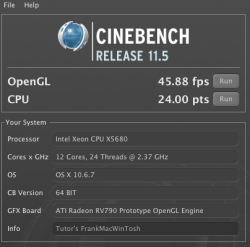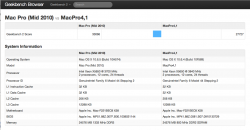Ok, I don't even know enough to be dangerous here, but what I understand is this:
My W3680 has a CPU freq. of 133MHz, and a multiplier of 25. 133x25=3.325GHz
When turbo kicks in, it adds a multiplier or two, depending on number of cores, which yields up to:
133x27=3.591GHz (3.6 on Intel's spec sheet)
What I'm missing is how you're underclocking for more performance. Are you changing the CPU frequency from say, 133MHz to 200MHz and running with the turbo bias multiplier of 27, for example?
Yep, in part.
wonderspark said:
Or is it the other way around, and you lower the freq to 100MHz and use more multipliers somehow, like 100MHz x40 multiplier?
Nope, but you've but your finger on one way it might be done with SandyBees, but that is highly dependent on what the motherboard makers expose through their bios implementations.
wonderspark said:
You're getting warm.
wonderspark said:
I don't get what you're doing to underclock and boost performance while maintaining cool temps and low voltages, and I'm not even an overclocker, so I really don't know jack. I probably won't do any of this for a while, since I'd prefer to play on a machine I don't rely on for income, but the first step is always knowledge. If I get it, I might be able to move on to experimenting.
I'll approach explaining what I do in two ways.
1) One way involves your buying one of those new Sandy Bridge E5 2012 Mac Pros. Done! Explanantion over - well sort of. Intel is now doing for the Sandy Bridges what I did for my Westmeres, the only differences being that I exaggerate it by setting the base from which turbo kicks in lower than the factory setting, and forcing a high turbo span. If you've been following the Sandy Bridge threads, you've seen that some complain about how these new chips run at slower clock speeds. Well, so do mine. And you may have noticed that these new chips have more steps/bins for turbo boosting than did Westmeres and earlier CPU generations. Well, so do mine - just that mine are higher, in fact almost doubled that coming standard in the SandyBees, because my chips and motherboards allow it.
2) Second way is a little more complicated, but here is how it goes:
Step one - you set the CPU ratio to as low a number as your computer will allow while giving you access to all of the variables necessary to have your system perform just as it would if you wanted it to run cool forever. My system with dual 5680s (rated at 3.33 GHz) has a non-turbo ratio range of 12 to 25 for them. That 12 setting stinks as it turns off some of those variables I'll mention below - so I can only go down to 13. Factory turbo for four of those six cores is 26 (I call this stage 1 turbo) and factory turbo for two of those six cores is 27 (I call this stage 2 turbo). It's not a coincidence that if you multiply a CPU's Base Clock (or Bclock or BCLK) by its highest, non-turbo CPU ratio at factory settings, you get its non-turbo speed as we're used to referring to it, namely, 133 (BCLK) x 25 = 3,325 MHz or 3.33 GHz (isn't rounding great) for all six cores when turbo isn't activated. Try to think of BCLK as, in a sense, a measure of the number of footsteps steps within a bin - those CPU ratios are each a bin, i.e., the 12, 13, 25, 26 and 27 {also just like the one's you mentioned}. View the number of footsteps as a proxy for speed with more footsteps representing more speed. For Westmeres, the normal span of footsteps is 133 MHz. For Sandy Bridges, the span is 100 MHz, but it'll be made up by the fact that they're wearing Nikes that can push more important stuff through faster. So at stage 1 turbo, four of each one of my 5680's six cores get kicked up to 133 x 26 = 3,458 MHz or 3.46 GHz (that's rounding again) and at stage 2 turbo, two of six cores get kicked up to 133 x 27 = 3,591 MHz or 3.59 Ghz {all of this also describes your system}. But in my case at this stage because I have chosen a lower CPU ratio, namely that 13 figure, we would get the following equations: 133 x 13 = 1,729 MHz or 1.73 GHz for all six cores at idle, or even lower with Speedstep. But because of a little instuction I give my systems through something called a DSDT.aml file [like the velociraptor in Jurassic Park - "It remembers"; here, what its true potential really is], at stage 1 turbo, four of six cores will still get kicked up to 133 x 26 = 3,458 MHz or 3.46 GHz and at stage 2 turbo, two of six cores will still get kicked up to 133 x 27 = 3,591 MHz or 3.59 Ghz. This turboboost activity is occurring continuously under load, assuming the right environment exists, faster than you could ever imagine. The more cores you have, the more fresh ones you have to participate in this round robin, if you stay within spec VID. See CPU-World site to get this Intel limit for your CPU - it's the amount of voltage you want to stay under to eat your cake and then have it to and keep your system stable, cool and not gulping on humongous electrical currents. This is the environment in which turbo thrives. For you true traditional overclockers, many of the variables you've been told to turn off, are fully enabled on all of my post-2008 systems: HPET 64, turbo boost, hyperthreading, and every native power management feature, including the PCIE/video ones, Speedstep, C1E, C/P/T states - they're all enabled. True overclockers also usually shoot for running all of their CPU's cores at one top stable speed, forgetting that overclocking and overvolting don't yield linear performance, but can yield heat exponentially. I SHALL NOT OVERVOLT ANY MORE,
and surely a whole lot less, unless I really,really,triple really have to and then just a little.
Step two - you increase the BCLK. Just imagine again that the 133 (Westmeres and older) and 100 (SandyBees) represent foot steps. Increasing the Bclock from 133 to, e.g., 170 makes for many more footsteps in a given span of time. By the way, note the ratio: 170/133 = 1.28. It not only applies to the CPU's speed, albeit and most importantly to only a subset of cores at a time, but it also get applied to the memory and the connection between the processors, speeding them up as well. Unfortunately with the SandyBees it gets applied to even more things [like the PCIE bus] than I care to mention, but that's another tome that I defer writing until Intel's next announcement. Now apply the equations in step one, using 170, instead of 133. It works out as follow: 170 x 13 = 2,210 MHz or 2.21 GHz for all six cores at idle. But because it remembers what its true potential really is, at stage 1 turbo, four of six cores will now get kicked up to 170 x 26 = 4,420 MHz or 4.42 GHz and at stage 2 turbo, two of six cores will now get kicked up to 170 x 27 = 4,590 MHz or 4.59 Ghz. And that's the story that gets told twice with dual cores, i.e., at stage 1 turbo, eight of twelve cores now get kicked up to 4.42 GHz and at stage 2 turbo, four of twelve cores get kicked up to 4.59 GHz. And recall that this is occurring faster than you could ever imagine. When turbo queries: "Are all environmental variables extant for me began the hunt" The answer is invariably "hell yes." The total 2.21 GHz system is cool, sub-VID, not power gulping because that's it strolling with the tortoises. Even while running benches while simultaneously rendering video in Final Cut X and animations in Cinema 4d or Maya, my core temps stay relatively very cool, albeit fluctuating greatly while in the hunt. But if you were to ask, "Why is it better to be running fewer than all cores at max?" I would respond, "That's why I call it a 'paradox' and me who loves a good paradox a 'contrarian.'" But to give you a real world reference - what is the attribute that distinguishes the fastest factory clocked Sandybee from the rest of them. If you said it was, is and will be a four core, you'd be right - fewer cores can operated faster, safely in an extremely compact CPU environment than can the many. That's another reason why my system runs cooler than many and doesn't require much voltage and does not consume lots of current - yet another reason for me to rejoice because turbo is firmly always at hand. Moreover, keep in mind that I'm not discussing a static grouping where the same cores fall in the same four or two core turbo group. Quite to the contrary, it's truly a round robin and they all get to mingle with one another in different groups, again, faster than you care to and can imagine. Then, when the load is completed and turbo isn't needed any longer, all of those cores tuck their head into the CPU's shell, returning to creeping along with the 2.21 GHz tortoises, or even slower with Speedstep, until more prey is spotted; then, they morph and the WolfPack is released again. This is how my turbo biased, underclocked, undervolted 2 CPU system (40,100) can feed with the 4+CPU/48+core predators in territory [
http://browse.geekbench.ca/geekbench2/top ] where overheated and/or overvolted, traditionally overclocked 2 CPU systems have yet to be spotted nearby. But far off on the horizon, I can see Echrei (33,344) - the famed overclocker and my mentor d00d (33,066) who taught me that when tuning a system less can be more, licking their chops, eager to join me in the hunt. I look forward to their arrival, but they may have to share future prey with my upcoming WolfPack3, my forray into the new territory soon to be dominated by the SandyBee.



